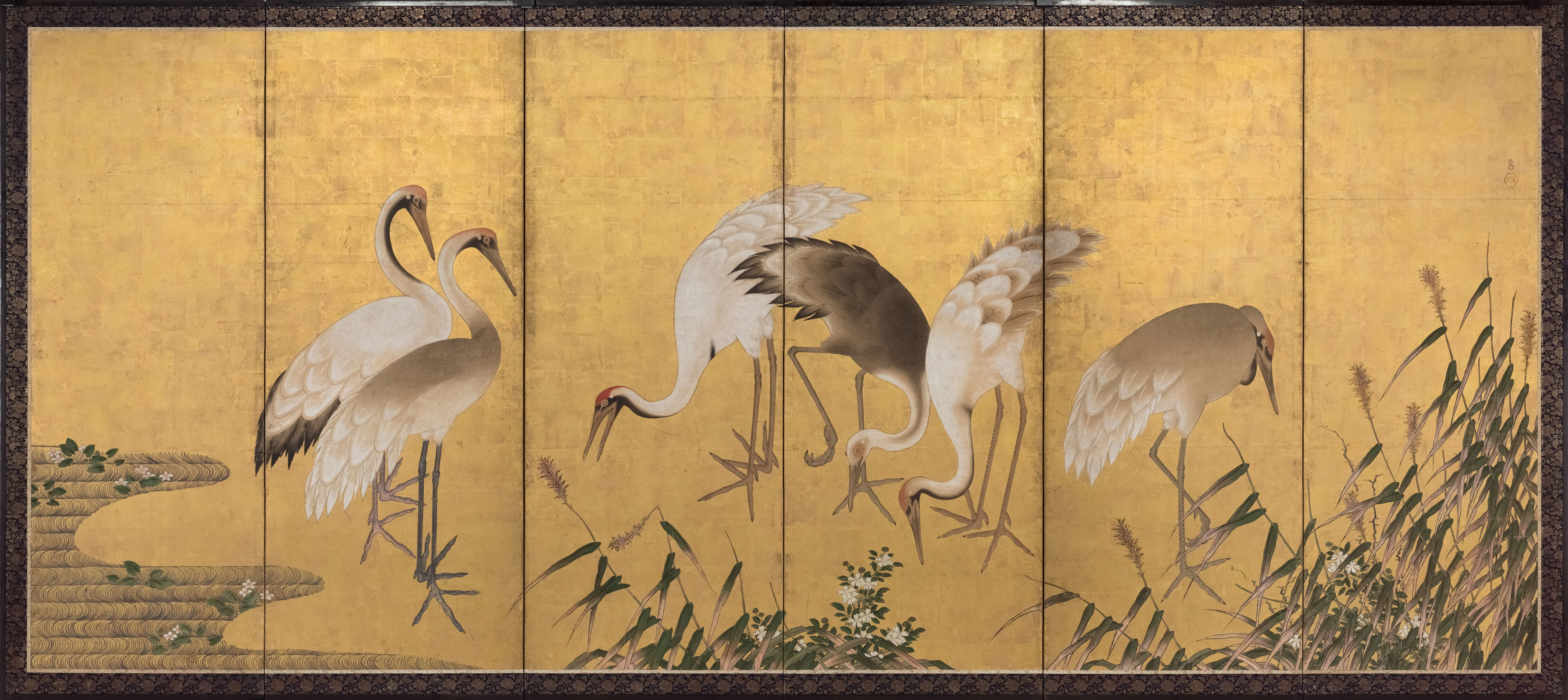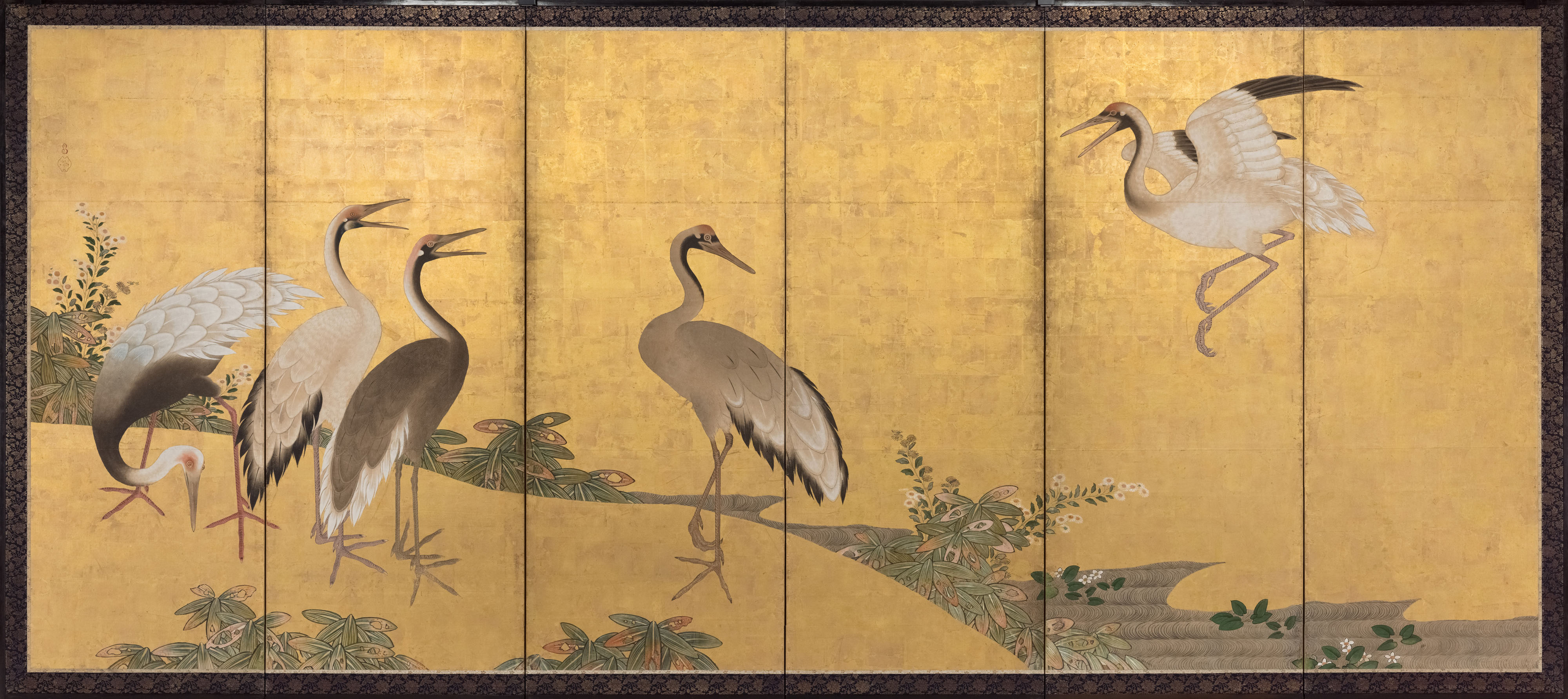
ぐんかくず 群鶴図
不詳(江戸時代 17世紀)
紙本金地着色
雲谷派3代・等與による花鳥図の代表作。金箔を押した画面に、鶴の群れを描く「群鶴図」は、祖父である初代・等顔の時代に、雲谷派の花鳥図の典型的な画題となりました。父等益は日本古来のやまと絵のモチーフを取り入れ、画面の装飾性を高めることに成功しています。等與はその傾向をさらに強め、本図では鶴、芦、水面などの形や模様をパターン化し、よりデザイン的な内容へと展開しました。タンチョウ、マナヅルなど種類の異なる鶴や可憐な草花、反復する笹も、画面にいっそうの華やかさと規則性を加えています。
金一色の背景やデザイン的な構成では“琳派(りんぱ)”の作風が代表的です。等與と同時代の画家に琳派の祖・俵屋宗達(たわらやそうたつ)がいます。宗達は京都の画家であり、等與は京都を訪れる際、流行をみせる宗達の作品を目にすることもあったでしょう。水墨画を得意とする雪舟流の画家でありながら、時代の趣味にも敏感だった等與の感性がうかがい知れる作品です。
雲谷等與【うんこく とうよ】
生没年 1612~1668【慶長17年~寛文8年)
雲谷等益の長男として生まれ、雲谷派3代目を継ぎ「雪舟五世」を称しました。萩を拠点に京都・大徳寺碧玉庵(へきぎょくあん)の襖絵制作を行い、明暦元年(1655)には京都御所の障壁画制作に参加。寛永16年(1639)法橋(ほっきょう)、寛文7年(1667)法眼(ほうげん)に叙任。等益様式を継承しながら、琳派(りんぱ)的作風など時代の流行も取り入れた画風を展開しました。
| 寸法 | [左]153.7×364.2/[右]154.0×364.6 cm |
|---|---|
| 形状 | 六曲屏風 |

Cranes
Color and gold leaf on paper
This work is one of the masterpieces of the third leader of the Unkoku School, Toyo. During the time of his grandfather, Togan, the founder of the Unkoku School, cranes, such as the depiction of a group of cranes against a gilded background, became representative of the Unkoku School’s kacho-zu (a genre of paintings depicting flowers and birds as subjects). His father, Toeki, succeeded in enhancing the decorative quality of the School’s pictures by introducing Yamato-e painting themes. These were traditional paintings of the late Heian (794 -1185) and Kamakura (1185 -1333) periods dealing with Japanese themes. Toyo enhanced this trend, as developed by his father, even more. In this work, he has rendered the shapes and patterns of the cranes, reeds and the water’s surface in a stylized manner, to develop a more design-oriented picture. This picture achieves even more brilliance and regularity by the depiction of different kinds of cranes, such as red-crowned and white-necked cranes, various attractive flowers, and the forms of bamboo grass leaves repeated harmoniously.
Pictures featuring a background painted entirely in gold and a design-centric composition are typical of works of the Rinpa School, one of the major traditional schools of painting created in 17th century Japan. The Rinpa School was founded by Tawaraya Sotatsu, who was a contemporary of Toyo and lived in Kyoto. Toyo may have had the opportunity to see Sotatsu’s works, which were popular among people of the time. Toyo was a Sesshu-style painter who was skilled at India ink painting, but this work suggests his acute sensitivity to the tastes of his time.
Unkoku Toyo (1612 – 1668)
Toyo was the first son of Unkoku Toeki. He became the third head of the Unkoku School and called himself Sesshu V. Although based in Hagi (the present-day Hagi City, Yamaguchi Prefecture), he worked in various other parts of the country, including Kyoto. There he produced fusuma-e (paintings on sliding doors) for the Hekigyoku-an Temple, a minor temple in the Daitoku-ji Temple precincts. He also participated in a project for producing paintings on the walls and fusuma (sliding doors) of the Kyoto Imperial Palace. He became hokkyo (the third highest rank in the hierarchy of Buddhist monks) in 1639 and was then promoted to hogen (the second highest rank) in 1667. Although he followed Toeki’s style in general, he also developed a new style that incorporated fashions of the time, such as the Rinpa style.
| Size | 153.7×364.2/154.0×364.6 cm |
|---|

群鶴圖
雲穀派3代——等與的花鳥圖代表作。貼滿金箔的畫麵上描繪著鶴群的《群鶴圖》,這是祖父——第一代等顏時代,樹立的雲穀派花鳥圖的典型畫題。父親等益吸收了日本自古以來的大和繪風格,成功地提高了畫麵的裝飾效果。等與進一步強化了這種裝飾傾向,本圖中對仙鶴、蘆葦、水麵等形狀以及紋樣進行模式化處理,內容更具設計感。丹頂鶴、白枕鶴等種類各異的仙鶴,可愛的花草,反複的竹葉,讓畫麵更顯華麗,也更具規律性。
在金色背景與設計構圖上,“琳派”風格最具代表性。與等與同時代的畫家還有琳派祖師——俵屋宗達。宗達是京都的畫家,等與在訪問京都時,可能曾看過流行的宗達作品。等與是擅長水墨畫的雪舟流派畫家,從作品可見其感性以及對時代趣味的敏感。
雲穀 等與
生卒年 1612~1668(慶長17年~寛文8年)
生為雲穀等益的長子,作為雲穀派第三代傳人,號稱“雪舟五世”。以萩市為據點,繪製了京都大德寺碧玉庵的隔扇畫,明曆元年(1655年)參加京都禦所的隔扇壁畫製作。寬永16年(1639年)繼任法橋(僧位)、寬文7年(1667年)繼任法眼(僧位)。延續了等益的畫風,也添加了時代流行的琳派畫風元素。
| 尺寸 | 153.7×364.2/154.0×364.6 cm |
|---|

군학도
운코쿠파 제3대 당주, 도요의 화조도 대표작입니다. 금박을 입힌 배경 위에 학 무리를 그리는 「군학도」는, 그의 조부인 초대 당주 도간 시대 당시, 운코쿠파 화조도의 전형적인 그림 주제였습니다. 아버지 도에키는 예로부터 내려오던 일본 고유 전통 양식인 ‘야마토에’에 사용됐던 모티브를 가지고, 그림 전체의 장식성을 높이는 것에 성공했습니다. 도요는 그 경향을 더욱 강화시켜, 본 작품에서는 학, 갈대, 수면 등의 형태나 무늬 등을 패턴화하여, 보다 디자인적인 내용으로 발전 시켜갔습니다. 두루미와 재두루미 등 종류가 다른 학이나 가련한 풀꽃, 반복되는 조릿대 등이 그림을 한층 더 화려하게 만들어주면서 그림에 규칙성도 더해주고 있습니다.
금색만을 사용한 배경과 디자인 적인 구성으로는 “린파”의 작풍이 대표적입니다. 도요와 동시대의 화가 중에는 린파의 시조인 다와라야 소타츠가 있습니다. 소타츠는 교토에서 활동한 화가인데, 도요는 교토를 방문했을 때 당시의 유행이 보이는 소타츠의 작품을 본적이 있을 것입니다. 수묵화에 능한 셋슈류의 화가이면서 당시의 트랜드에도 민감했던 도요의 감성이 엿보이는 작품입니다.
운코쿠 도요
생몰년 1612년 ~1668년 (게이초17년~간분8년)
운코쿠 도에키의 장남으로 태어나 운코쿠파 제3대 당주로서 아버지의 뒤를 이었고, 「셋슈5대」를 위명했습니다. 하기를 거점으로 교토 다이토쿠지 절 벽옥암(*일본어 음독: 헤키교쿠안)의 장벽화(후스마에)를 제작하였고, 1655년(메이레키 원년)에는 교토의 고쇼(궁궐) 장벽화제작에 참여하였습니다. 1639년(간에이16년)에는 ‘법교(法橋)’에, 1667년(간분7년)에는 ‘법안(法眼)’에 서임합니다. 도에키 양식을 계승하면서 린파의 작풍 등 시대의 유행에도 따르는 화풍을 선보였습니다.
| 치수 | 153.7×364.2/154.0×364.6 cm |
|---|


